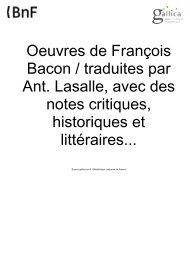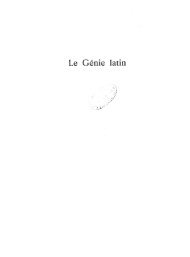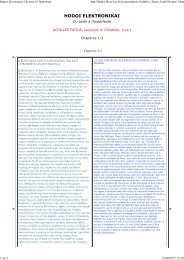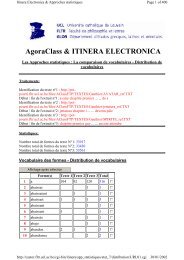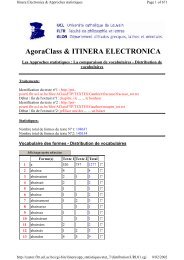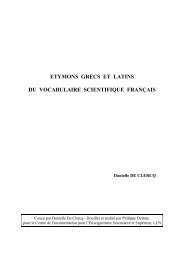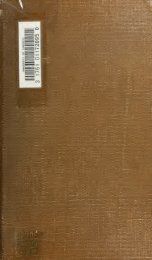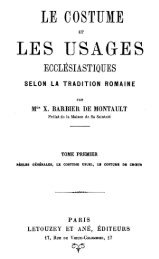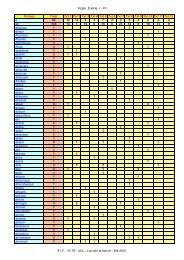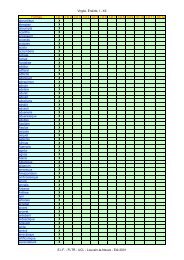The Etymologies of Isidore of Seville - Pot-pourri
The Etymologies of Isidore of Seville - Pot-pourri
The Etymologies of Isidore of Seville - Pot-pourri
You also want an ePaper? Increase the reach of your titles
YUMPU automatically turns print PDFs into web optimized ePapers that Google loves.
Straw mat (storia), because it isspread(strata) onthe<br />
ground. 2. Acot(cama) islow and close to the ground,<br />
for the Greeks say (lit. “on the ground”) for ‘low.’<br />
Acouch(cubile)isaplace for lying down (cubare). ‘Pallet’<br />
(grabatum) isaGreek term. A camp-bed (baianula)<br />
isabed that is hauled (baiulare) onatrip,from<br />
‘hauling,’ that is, carrying. 3. A‘cushioned couch’ (pulvinar)<br />
isacouch for the wealthy; hence also ‘pillow’<br />
(pulvillus). Spinga (i.e. sphinga)beds are those on which<br />
there are images <strong>of</strong> sphinxes, which we call griffins. Punic<br />
(Punicanus)bedsaresmall,lowbedsfirstimportedfrom<br />
Carthage, and hence named. 4. Lectica is the name for<br />
a‘bedwithaback’(pluteus lectus). Concerning these,<br />
Rutilius Rufus says in On His Own Life (13): “First, contrary<br />
to the custom <strong>of</strong> generals, he would use couches<br />
with backs (lectica) inpreference to couches without<br />
backs (lectus).” 5. <strong>The</strong>frame (sponda) isthe outer part<br />
<strong>of</strong> a bed, the backboard (pluteus) the inner.<br />
Bridal (genialis) beds properly speaking are those<br />
spread for young brides, so called from begetting (generare)<br />
children. 6. Acradle (cunabula) isalittle bed in<br />
which infants usually lie, so called because they are used<br />
for a new-born, asifitwerecynabula –for means<br />
“to give birth” in Greek. 7. Abier(feretrum) issocalled<br />
because the dead are ‘carried <strong>of</strong>f’ (deferre) onit,and<br />
it is a Greek word, for is taken from ,<br />
that is, from carrying (ferre). In Latin a c<strong>of</strong>fin (capulus)<br />
is so called because it is carried above people’s heads<br />
(caput). Thus Plautus says (<strong>The</strong> Braggart Soldier 628):<br />
“C<strong>of</strong>fin-bound (capularis) old man,” that is, nearly in<br />
his c<strong>of</strong>fin. 8. Stools(scamnum) aresetagainst very high<br />
beds, and are so called from ‘climbing’ (scandere), [that<br />
is, mounting (ascendere)]. Hence also ‘footstools’ (scabillum),<br />
which are set by small beds or chairs for mounting.<br />
<strong>The</strong> footstool is also called a subpedaneum, for what<br />
the Greeks call Latin speakers call scabillum,<br />
and others [call] suppedaneum, because it is ‘under the<br />
feet’ (sub pedes). A scansilium is a step (e.g. a bench in<br />
an amphitheater) where a distinguished person takes<br />
his seat. 9.Seats (sedes)are so called because among the<br />
ancient Romans there was not the practice <strong>of</strong> reclining at<br />
table, and hence they were said to ‘sit down’ (considere).<br />
Afterwards, as Varro says in On the Life <strong>of</strong>theRoman<br />
People,men began to recline and women to sit, because<br />
reclining was seen as unseemly for a woman.<br />
<strong>The</strong> word ‘seat’ (sedis,i.e. sedes)inthe singular number<br />
properly belongs to kingship, and in Greek is called<br />
<strong>The</strong> <strong>Etymologies</strong> XX.xi.2–xii.5 403<br />
. <strong>The</strong>Greeks say thronus, andwesay solium. But<br />
for other people, there are ‘benches’ (subsellium); for<br />
scholars, ‘chairs’ (cathedra). 10.<strong>The</strong>throne (solium), on<br />
which kings sit for the safety <strong>of</strong> their bodies, is so called,<br />
according to some, for its ‘solidity’ (soliditas), as if it were<br />
solidum;according to others the word is formed by antistichon<br />
(i.e. by antistoechum,“substitution <strong>of</strong> letters”) as<br />
if the word were sodium, from ‘sitting’ (sedere). Hence<br />
likewise sella (i.e. another word for ‘seat’) is so called as<br />
if it were sedda, andbenches (subsellium) asiftheword<br />
were subseddium. 11. <strong>The</strong> ‘curule chair’ (sella curulis) is<br />
where magistrates would sit (sedere) torenderjustice.<br />
<strong>The</strong>y are called ‘curule’ because, among the ancients,<br />
praetors and consuls would be carried to the forum by<br />
achariot(currus) due to the length <strong>of</strong> the journey. <strong>The</strong><br />
chairs that were carried after them, from which while<br />
sitting they would render justice, were named ‘curule’<br />
chairs from ‘chariot.’ 12.Tripods (tripus)arestools having<br />
‘three feet’ (tres + pes; - + ). But lampstands<br />
are also tripods because they likewise have three feet.<br />
xii. Vehicles (De vehiculis) 1. Awagon(carrum) isso<br />
called from the axle (cardo) <strong>of</strong>itswheels,andhence<br />
‘chariot’ (currus)isnamed, for it is seen to have wheels.<br />
Awheel(rota)issocalled because it rushes (ruere), and<br />
‘round’ (rotundus) isnamed from rota. 2. Areda is a<br />
kind <strong>of</strong> vehicle with four wheels. <strong>The</strong> ancients called<br />
these retae,because they had wheels (rota). 3.Acarpentum<br />
pompaticum (i.e. a processional carriage) is a type<br />
<strong>of</strong> vehicle, as if it were a carrum pompaticum. Acart<br />
(plaustrum) isatwo-wheeled vehicle that carries burdens,<br />
and is called plaustrum because it rolls, as if one<br />
said pilastrum (cf. pila,“ball.”). A caracutium is a vehicle<br />
with very high wheels, as if it were a ‘high wagon’ (carrum<br />
acutum). A capsus is a carriage enclosed on all sides,<br />
as if it were abox(capsa). 4. Apilentum or petorritum<br />
is an enclosed carriage with four wheels that matrons<br />
formerly used. Vergil (Aen. 8.666):<br />
Mothers in s<strong>of</strong>t carriages (pilentum).<br />
Horace (Satires 1.6.104):<br />
Many grooms and nags to be grazed, and carriages<br />
(petorritum) tobedrawn.<br />
Formerly the pilentum was <strong>of</strong> a blue color and not, as<br />
it now is, red. Unless they were chaste, matrons could<br />
not use these; nor, likewise, could they wear fillets. 5. A



